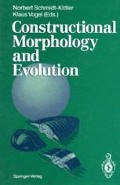Summary
The relationship of construction and behavior in the evolutionary process is discussed on the basis of comparison of malformed bills of avian species with the normal, but specialized bills of other species. The following insights emerged:
-
1.
1. Construction and behavior can be evaluated only on the foundation of their interactions.
-
2.
Construction and behavior can vary independently from each other within certain limits.
-
3.
As a rule, behavior seems to act as a selective force on the variants of the construction. This means that the organism produces an own canalizing (selective) factor in addition to, and reaching beyond the canalizing limitations of the mere constructional constraints of its coherent system.
-
4.
Through its behavior the organism involves parts of the environment in its activities. The concept of adaptation is meaningful only in this context.
-
5.
The environment cannot bring about organismic variations; the environment is not creative, it can only eradicate.
-
6.
The insight that behavior channels construction can be helpful in attempts to reconstruct the evolutionary process, even if it sometimes helps only to understand why a certain reconstruction cannot be achieved.
Access this chapter
Tax calculation will be finalised at checkout
Purchases are for personal use only
Preview
Unable to display preview. Download preview PDF.
References
Bock WJ (1959) Preadaptation and multiple evolutionary pathways. Evolution 13:194–211
Bock WJ, Wahlert G von (1965) Adaptation and the form-function complex. Evolution 19: 269–299
Bonik K, Gutmann WF, Peters DS (1977) Optimierung und Ökonomisierung im Kontext von Evolutionstheorie und phylogenetischer Rekonstruktion. Acta Biotheor 26:75–119
Cramp S (ed) (1985) Handbook of the birds of Europe, the Middle East, and North Africa, vol 4. Oxford Univ Press, Oxford NY
Gutmann WF (1989) Die Evolution hydraulischer Konstruktionen: Organismische Wandlung statt altdarwinistischer Anpassung. Kramer, Frankfurt/M
Lack D (1947) Darwin’s finches. Cambridge Univ Press, Cambridge London New York
Lorenz K (1975) Die Rückseite des Spiegels. Piper, München
Mayr E (1958) Behavior and systematics. In: Roe A, Simpson GG (eds) Behavior and evolution. Yale Univ Press, New Haven, Conn, pp 341–362
Mayr E (1959) The emergence of evolutionary novelties. In: Tax S (ed) The evolution of life. Univ Press, Chicago, pp 349–380
Peters DS (1983) Evolutionary theory and its consequences for the concept of adaptation. In: Grene M (ed) Dimensions of Darwinism. Cambridge Univ Press, Cambridge London New York; and Editions de la Maison des Sciences de l’Homme, Paris, pp 315–327
Peters DS (1984) Evolutionstheorie — Zwangsläufigkeit und Grenzen. In: Kaiser P, Peters DS (eds) Evolutionstheorie und Schöpfungsverständnis. Pustet, Regensburg, pp 193–218
Peters DS (1985) Erneut vorgestellt: Das „Ökonomieprinzip“. Aufs Reden Senckenb Naturforsch Ges 35:143–153
Peters DS (1987) Juncitarsus merkeli n.sp. stützt die Ableitung der Flamingos von Regenpfeifervögeln (Aves: Charadriiformes: Phoenicopteridae). Courier Forschungsinst Senckenb 97:141–155
Peters DS, Gutmann WF (1971) Über die Lesrichtung von Merkmals- und Konstruktionsreihen. Z Zool Syst Evolutionsforsch 9(4):237–263
Uexküll J von (1909) Umwelt und Innenwelt der Tiere. Springer, Berlin
Vogel S (1974) Ölblumen und ölsammelnde Bienen. Steiner, Wiesbaden
Vogel S (1981) Abdominal oil-mopping — a new type of foraging in bees. Naturwissenschaften 67:627–628
Author information
Authors and Affiliations
Editor information
Editors and Affiliations
Rights and permissions
Copyright information
© 1991 Springer-Verlag Berlin Heidelberg
About this paper
Cite this paper
Peters, D.S. (1991). Behavior plus “Pathology” — the Origin of Adaptations?. In: Schmidt-Kittler, N., Vogel, K. (eds) Constructional Morphology and Evolution. Springer, Berlin, Heidelberg. https://doi.org/10.1007/978-3-642-76156-0_11
Download citation
DOI: https://doi.org/10.1007/978-3-642-76156-0_11
Publisher Name: Springer, Berlin, Heidelberg
Print ISBN: 978-3-642-76158-4
Online ISBN: 978-3-642-76156-0
eBook Packages: Springer Book Archive

